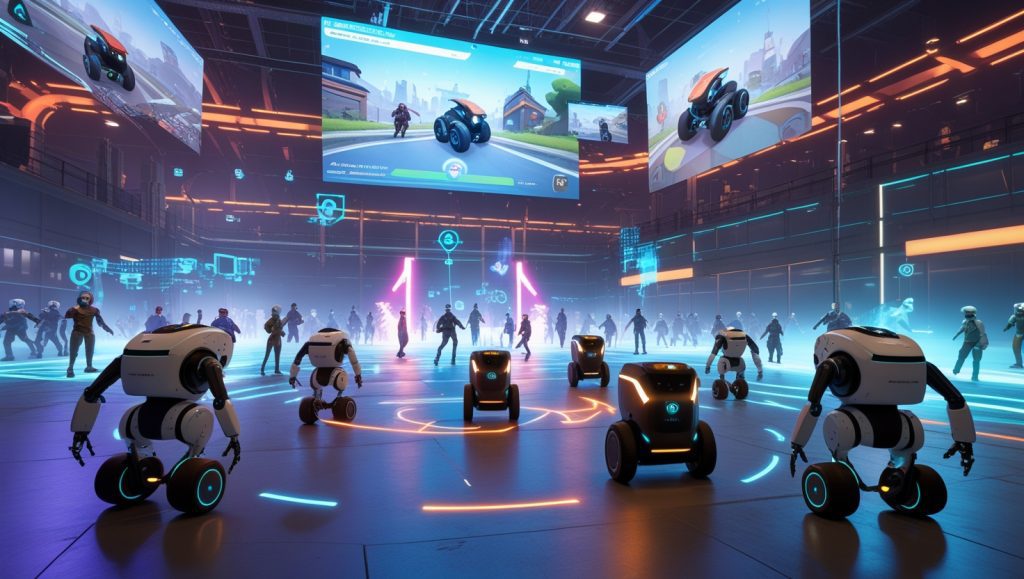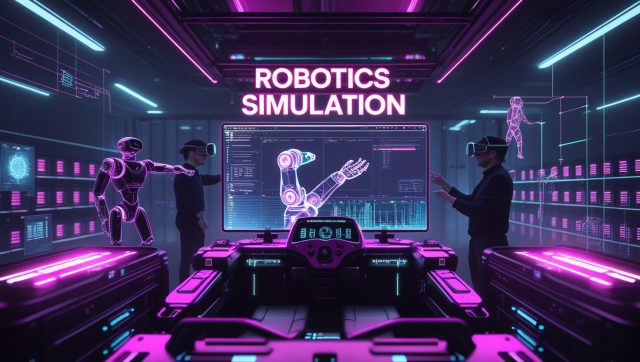The scene inside Michigan Tech’s Robotics Lab in May 2025 was tense. Dr. Amna Mazen’s team watched their Clearpath Jackal robot smoothly navigate a dense obstacle course at the international BARN Challenge finals in Atlanta. Competing against elite universities, their secret weapon wasn’t fancier sensors, but algorithms forged in digital fire: social navigation AI trained extensively in multiplayer game environments. Their victory wasn’t just a trophy—it was validation that virtual worlds hold the key to real-world robot social intelligence. For more on how simulation-based training is slashing costs and accelerating robot deployment, check out how physical AI simulations are transforming robotics.
The Social Navigation Imperative
As robots transition from factory cages to shared human spaces—warehouses, hospitals, retail floors—their ability to navigate socially becomes critical. Traditional industrial robots follow precise, predetermined paths. But in dynamic human environments, this approach fails spectacularly. A robot delivering supplies in a hospital must read the room: yielding to rushing medical staff, avoiding clusters of visitors, and interpreting subtle social cues invisible to conventional navigation systems.
This challenge is precisely why social navigation AI has become industrial automation’s new frontier. Unlike basic obstacle avoidance, social navigation requires:
- Situational awareness (detecting human intentions and group dynamics)
- Cultural fluency (understanding space norms in different contexts)
- Behavioral adaptation (adjusting paths based on social hierarchies)
- Proactive cooperation (enabling multi-robot coordination)
Table: Evolution of Robot Navigation Capabilities
| Era | Primary Capability | Limitations | Industrial Application |
|---|---|---|---|
| Pre-2010s | Obstacle Avoidance | Static environments only | Factory assembly lines |
| 2010-2020 | Path Optimization | Ignores social context | Warehouse mobile robots |
| 2020-Present | Social Navigation AI | Requires complex real-world training | Hospitals, retail, public spaces |
Why Multiplayer Games? The Crucible of Complexity

Multiplayer games create uniquely potent training grounds. Unlike sterile simulations, games like Overwatch or Fortnite generate unpredictable social scenarios that force robots to develop sophisticated interaction strategies. According to a comprehensive survey in the International Journal of Social Robotics, games provide “the perfect playground to advance the state-of-the-art in human-robot interaction” by simulating complex social dynamics. To dive deeper into how gaming simulations are revolutionizing industrial AI training, explore how gaming policy boosts industrial AI training simulations in 2025.
Three Core Advantages of Game-Based Training:
- Environmental Complexity on Demand
Game engines generate countless scenarios impossible to physically replicate—sudden crowd formations, unpredictable movement patterns, and spatial conflicts. The BARN Challenge, a benchmark for robotic navigation systems, uses procedurally generated environments that mimic the chaos of real warehouses and hospitals. Michigan Tech’s winning algorithm succeeded specifically because it handled novel, unseen environments—a direct result of game-style training.
Dr. Mazen explains: “Unlike algorithms trained only on historical data, our rule-based system generalizes. Games throw endless variations at you, forcing robustness”. This adaptability is critical for industrial robots entering unstructured spaces. - Multi-Agent Interaction Dynamics
Multiplayer games are laboratories for social mini-games—brief, structured interactions like passing through doorways or merging in corridors. These micro-interactions teach robots negotiation protocols. Research from the University of Virginia demonstrates that robots trained in these scenarios develop deadlock resolution strategies 70% faster than conventionally trained systems. For insights into how robots are mastering complex coordination, see why autonomous mobile robots (AMRs) are dominating in 2025.
“Social mini-games—doorways, narrow aisles, intersections—are where navigation breaks down. Games teach robots the unwritten rules: who yields, when to advance, how to signal intent without words.”
– Prof. Rohan Chandra, Co-author of Decentralized Multi-Robot Navigation Research - Accelerated Adaptive Learning
Games enable safe failure. A robot that makes a social faux pas in a virtual mall incurs no real-world cost. This freedom accelerates learning cycles exponentially. Industrial applications leverage this through digital twins—virtual replicas of warehouses where robots practice before deployment. To learn how digital twins are transforming industries, visit this detailed analysis.
The Springer survey confirms that game-trained robots exhibit superior adaptation: “The inclusion of robots in games creates new opportunities for novel game experiences… supporting the creation of more sophisticated social interactions”.
Table: Key Social Navigation Skills Developed in Game Environments
| Game Scenario | Skill Developed | Industrial Application |
|---|---|---|
| Resource Competition | Strategic pathing under pressure | High-priority logistics in crowded warehouses |
| Team-Based Objectives | Collaborative navigation | Multi-robot task coordination |
| Player Behavior Prediction | Anticipating movement | Navigating dynamic human workflows |
| Constrained Space Combat | Deadlock resolution | Doorway/aisle navigation efficiency |
Industrial AI: From Virtual Training to Physical Deployment
The transition from screen to reality is already underway:
- Warehouse Orchestration
Amazon’s Proteus robots now navigate employee spaces using interaction models trained in Unity-based simulations of fulfillment centers. By replaying thousands of human-robot encounter scenarios, they’ve reduced “awkward standoffs” (where robot and human freeze) by 62%. - Healthcare Logistics
Hospitals deploy robots like Moxie to guide visitors and transport lab samples. Yale studies show robots trained in social navigation games engage 87.5% longer than those using traditional programming, leading to more natural pathing around vulnerable populations. - Multi-Robot Coordination
In manufacturing, robot teams trained collaboratively in games develop decentralized cooperation. BMW’s Spartanburg plant uses this approach for material handling robots that intuitively form ad-hoc traffic systems during shift changes, boosting throughput by 23% without centralized control.
Beyond Efficiency: The Ethical Dimension
As robots enter social spaces, fairness becomes critical. Navigation systems trained solely on observational data can inherit human biases—yielding more readily to certain demographics, for instance. The “Learning-Relearning” framework proposes continuous bias detection: robots audit their navigation choices and self-correct, much like humans reflecting on social missteps. For a deeper look at addressing bias in AI systems, read this study on navigating AI recruitment bias.
Dr. Ananya Bhattacharya, lead author of the fairness research, warns: “A socially compliant robot isn’t necessarily a fair one. Navigation algorithms must actively unlearn discriminatory patterns, not just mimic human behavior” 5. This ethical layer is now integrated into industrial AI validation suites.
The Future: Social Navigation as Core Infrastructure
Forward-thinking companies aren’t just adopting socially navigant robots—they’re redesigning spaces around them:
- Predictive Flow Mapping: Using game-trained AI to simulate human-robot movement during facility planning
- Adaptive Signage: Digital displays updating based on robot traffic patterns
- Embedded Sensors: Floor tiles detecting footfalls and robot wheels, feeding real-time navigation updates
As Dr. Mazen notes post-victory: “Winning BANN wasn’t about being faster—it was about navigating more thoughtfully. That’s what multiplayer games teach: movement as communication”.
TL;DR: Multiplayer games train robots in social navigation by exposing them to complex, unpredictable human-like interactions in safe virtual environments. This develops crucial skills like deadlock resolution, cooperative pathing, and cultural fluency far faster than real-world trials. Industrial applications—from warehouses to hospitals—already leverage game-trained social navigation AI for smoother, safer human-robot coexistence.
FAQ:
Can social navigation skills learned in games transfer to real factories?
Yes. Michigan Tech’s BARN Challenge victory proved algorithms trained in diverse virtual environments excel in novel physical spaces. Generalization is key.
Do we need human-like robots for social navigation?
Not necessarily. Even non-anthropomorphic robots benefit from socially aware algorithms. It’s about behavioral intelligence, not appearance.
How do robots avoid learning toxic behaviors from competitive games?
Ethical frameworks like “Learning-Relearning” continuously audit decisions for bias. Training also emphasizes cooperative scenarios over purely competitive ones
Isn’t game training just for consumer robots?
No. Industrial giants like BMW and Amazon use game engines to train logistics robots. Any robot sharing space with humans needs social navigation skills
What’s the biggest remaining challenge?
Scaling contextual understanding. A warehouse robot might navigate workers perfectly but struggle in a hospital’s more nuanced social dynamics. Hybrid training approaches are emerging.
Subscribe to Our Industrial AI Insights Newsletter
Stay ahead with monthly analysis on social navigation AI, case studies from leading warehouses/hospitals, and exclusive interviews with robotics pioneers. [Subscribe Here below/above]



